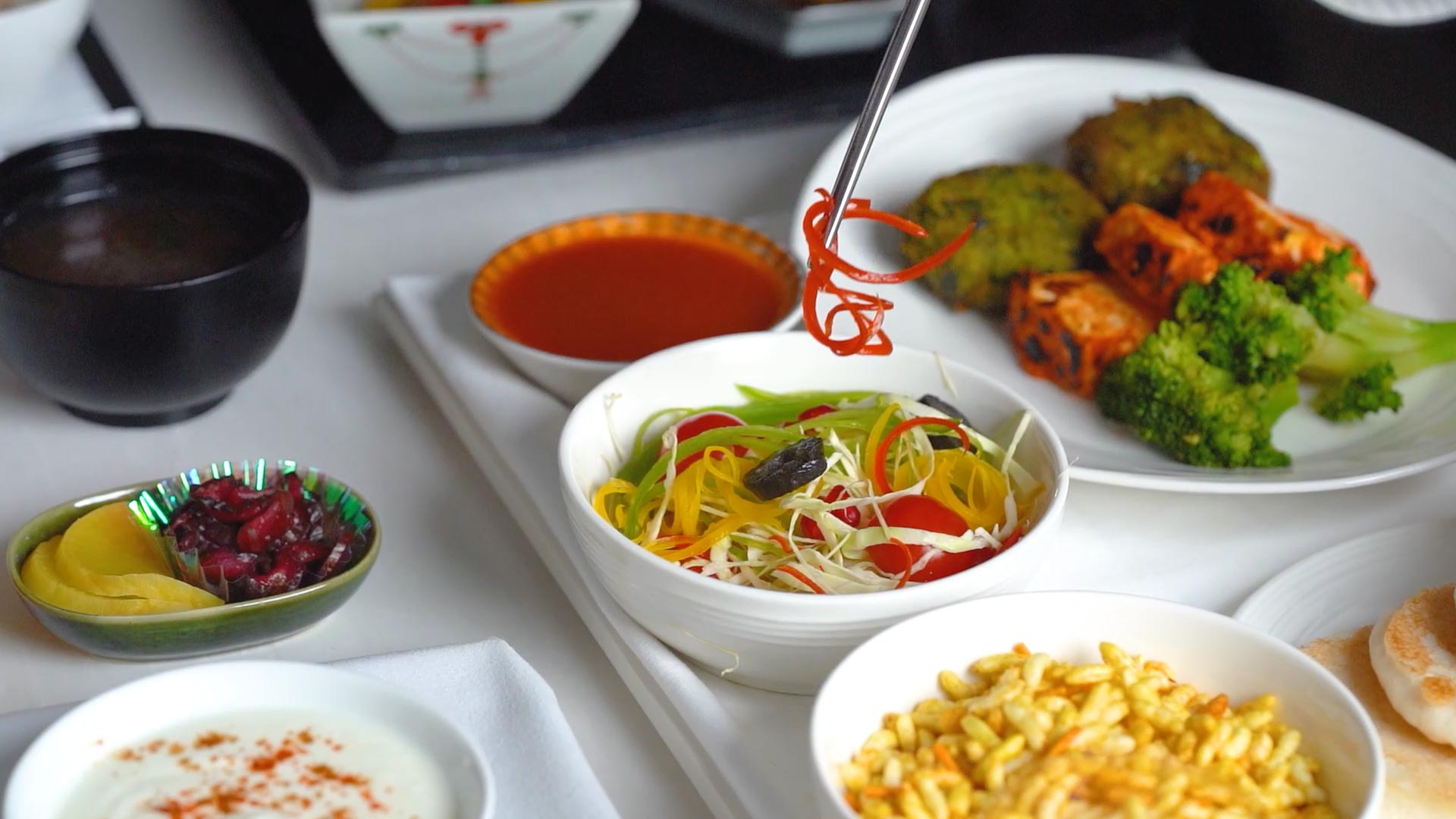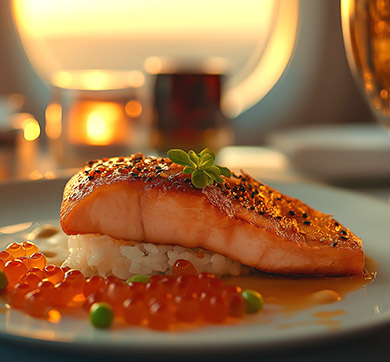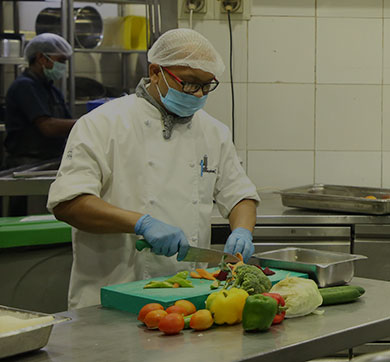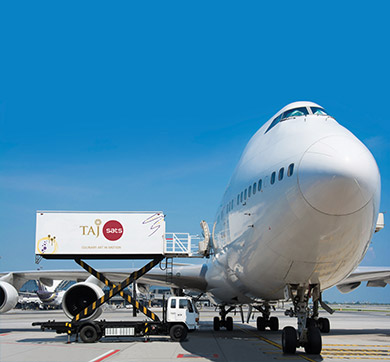May 2025 | 1687 words | 6-minute read
It is rush hour at the TajSATS 12,700 sq m Mumbai airline catering kitchen on a weekday morning. With several domestic and transatlantic flights due for take-off that day, the meals need to be ready hours in advance.
However, the 1,500-strong team, is accustomed to the frenetic pace of activity at this facility, located a stone’s throw from the Chhatrapati Shivaji Maharaj International Airport. It produces 50,000 meals daily — using nearly four tonnes of raw materials — catering to over 240 flights every day. Rush hour, as it turns out, is a 24-hour feature here.
A joint venture between Indian Hotels Company Ltd (IHCL) and SATS Ltd, TajSATS is India’s largest airline catering company, with a 60% market share, serving over 1,50,000 passengers daily and 5.5 crore annually. With 10 aviation kitchens in eight locations, including Mumbai, Delhi, Bengaluru, Chennai, Kolkata, Goa Dabolim, Goa Mopa and Amritsar, and two more slated to come up in Noida and Navi Mumbai, TajSATS is on an expansion spree.
Its complex operational systems make the aviation catering business singularly unique. TajSATS must abide by strict food safety regulations and work around the fact that food and drink taste starkly different in the air compared to on the ground. Reduced cabin air pressure — which dulls our tastebuds by ~30% — along with the lack of humidity and loud background noise of the engines affect passengers’ ability to taste at high altitudes. This, coupled with variables such as diverse tastes, hygiene and cost-effectiveness, mean airline catering is no easy task. But that hasn’t deterred TajSATS from pushing the envelope when it comes to what you can treat your tastebuds to at 35,000 feet.
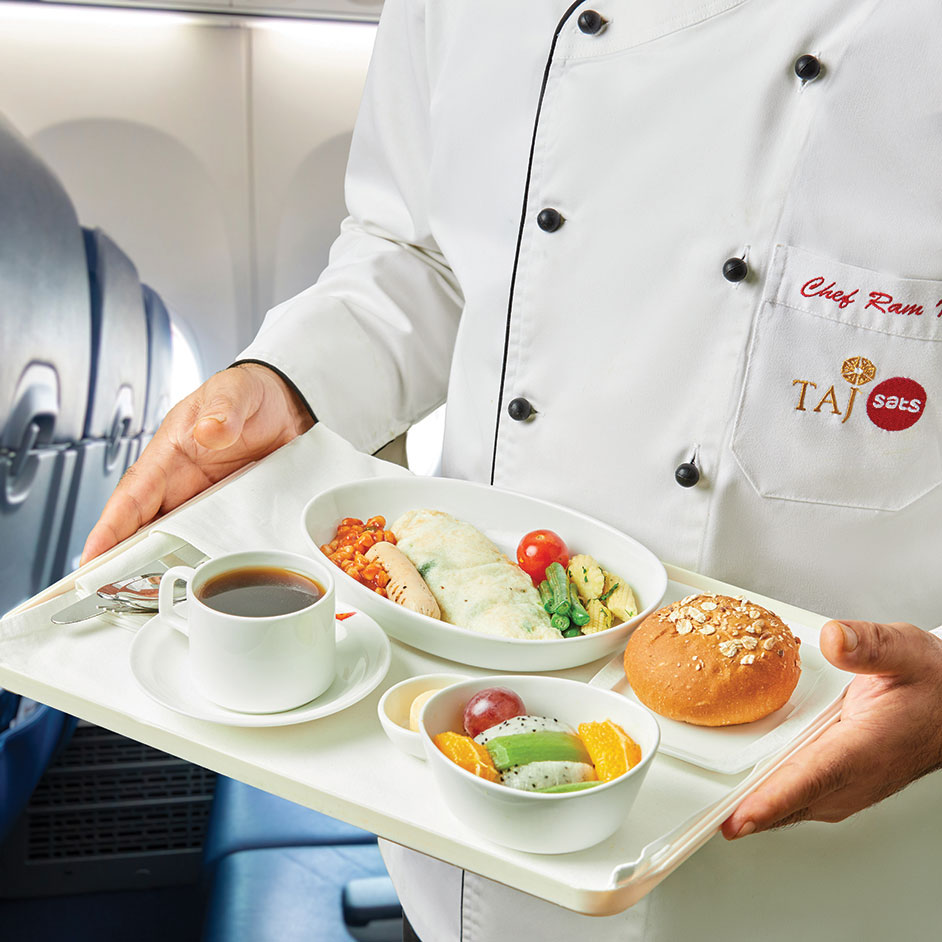
In 2020, the company was one of the first to introduce plant-based meats using soya and jackfruit to cater to flyers seeking healthier options. “Post-Covid, there has been a renewed focus on in-flight dining experiences,” says Manish Gupta, Chief Executive Officer, TajSATS. “With ‘revenge travel’ and the popularity of YOLO, people are willing to experiment with inflight food. There’s a shift towards a more adventurous palate and we are here to provide that.”
After all, the best way to a customer’s heart is through their stomach. So, how does TajSATS do it? We went behind the scenes to find out.
What’s on the menu?
It all starts with menu creation in a test kitchen. TajSATS’ chefs have to consider a range of factors, including what sector the airline is flying, passenger profile (first class, business class, premium economy and economy), the departure time, flight duration and, last but certainly not the least, what flyers want. TajSATS has a sleek and stylish food tasting studio called The Atelier where chefs showcase their culinary creations and finalise the menu, on receiving inputs from the airline.
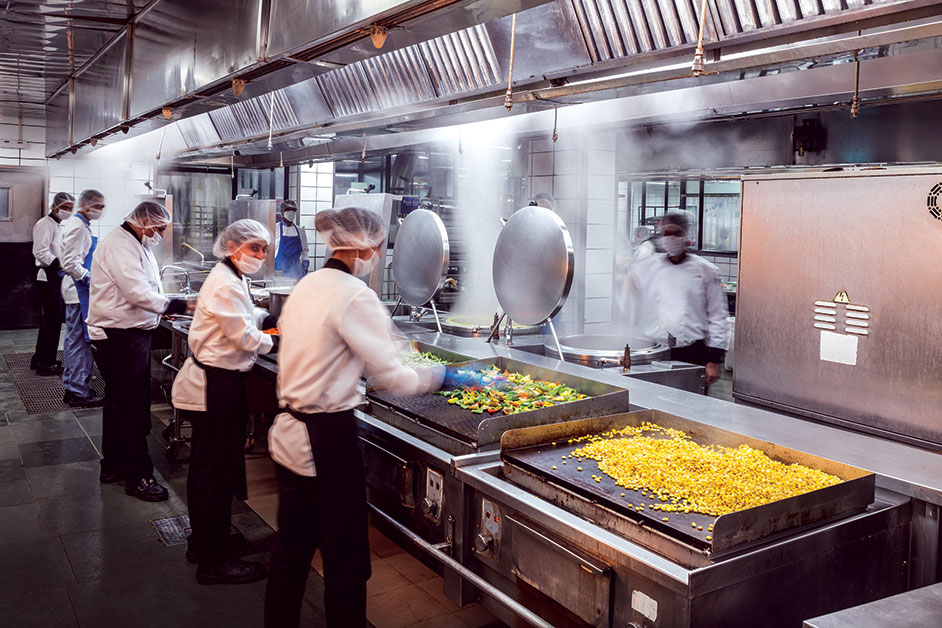
The most important aspect of the menu is the ingredients, notes Rajendra Nayal, Executive Chef, TajSATS Mumbai. “Some products or dishes need to be customised as per the availability of local ingredients,” he says. “Seasonality plays a big role here, as we want to take advantage of adding special ingredients such as strawberries in winter and mangoes during the summer.”
A clockwork kitchen
The kitchen, the beating heart of the facility, is ergonomically designed for maximum efficiency. “It’s a unilateral flow in the shape of a square, so that food moves seamlessly from the receiving section to the final dispatch section,” explains Chef Nayal. “Every department is interlinked with each other through storage spaces, whether deep freezers or chillers.” He explains that this layout has three major advantages: the ambassadors are confined to their area of work, there is minimal interaction between sections as products are pre-placed in their areas for pick up, and only the required number of employees are in each area, limiting interference from the outside.
Everything is designed to run like clockwork. Abdulla Khan, Procurement Head for TajSATS, says it is a business of high volume and high stakes. It is his responsibility to build a reliable network of suppliers who can provide high-quality products at the best possible price. Vendors are expected to adhere to strict timelines and regulations, such as temperature-controlled storage to ensure freshness. If one cog is out of place, the whole operation faces the risk of coming apart. “So, we always make sure there’s a plan B,” says Mr Khan. For all perishable items, the orders are sent to the vendors the previous evening. Vegetables, eggs, meat, fish, poultry and dairy come at a stipulated time to the facility every day. Time is of the essence as the entire process has to work with assembly-line efficiency to prepare thousands of meals within a few hours.
All incoming vegetables and meat are first sanitised in the Receiving Area before being shipped ahead. Grains are taken to the Dry Stores and sorted on magnetic sorting tables for any foreign objects and then packed in bags of 2kg, 5kg and 10kg. “This ensures that we remove additional waste in the production area and minimise the risk of foreign objects entering the space,” says Meherwan Karanjia, General Manager, TajSATS Mumbai. Non-vegetarian items are cleaned and sorted in the Butchery and eggs have their own sorting room. All ingredients are stored at temperatures as per regulatory guidelines and used in a first in, first out inventory system.
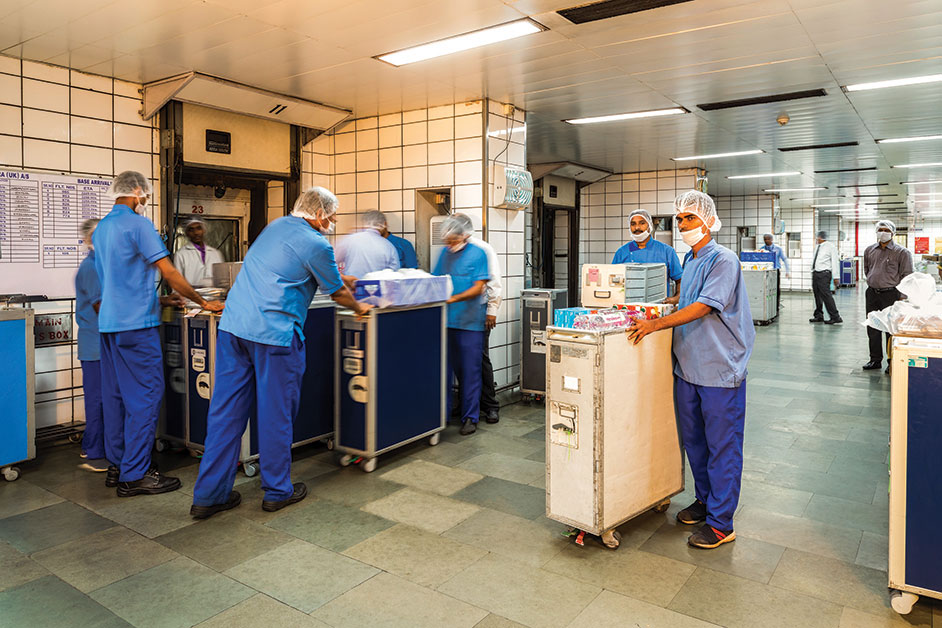
Next in line is one of the facility’s busiest areas — the Fruits and Vegetables section. Here, sanitised items are peeled, cut and checked for their final weight and nutritional value. The neighbouring area, Bakery and Confectionery — by far the most aromatic — is dotted with rows of gloriously flaky croissants and lemony tarts.
Run hot and cold
In the main cooking area, associates dressed in whites are working with precision across several assembly lines to prepare the food. The space is divided into a Hot Kitchen, where food is cooked, grilled, sautéed, roasted or fried, and a Cold Kitchen, where salads, dressings, cold sandwiches, cold desserts and cold food items are prepared. Each kitchen has clearly demarcated spaces for preparing vegetarian and non-vegetarian dishes.
Once the dishes are cooked in large steel vats, ovens, fryers or steamers, as needed, they are blast chilled and transported in refrigerated trolleys to the Cold Kitchen. Here, meals are portioned, labelled and once again chilled. Everything from crispy medu vadas to creamy pastas undergo this process given that temperature is crucial for preserving the quality of food and preventing bacterial growth. “In fact, temperature needs to be regulated throughout the entire supply chain, from the kitchen to the tray table,” says Chef Nayal.
Every morsel of food leaving the production area is inspected using AI-enabled X-ray machines that were installed last year — a first in the Indian airline industry. Flagged items are sent to the lab for further inspection. “The machines, that are installed in all our units, scan for and point out foreign objects of certain densities,” says Mr Karanjia. “Based on the scans, the system is constantly learning through AI to find and indicate the smallest objects in the food, which enables us to reduce contaminations.”
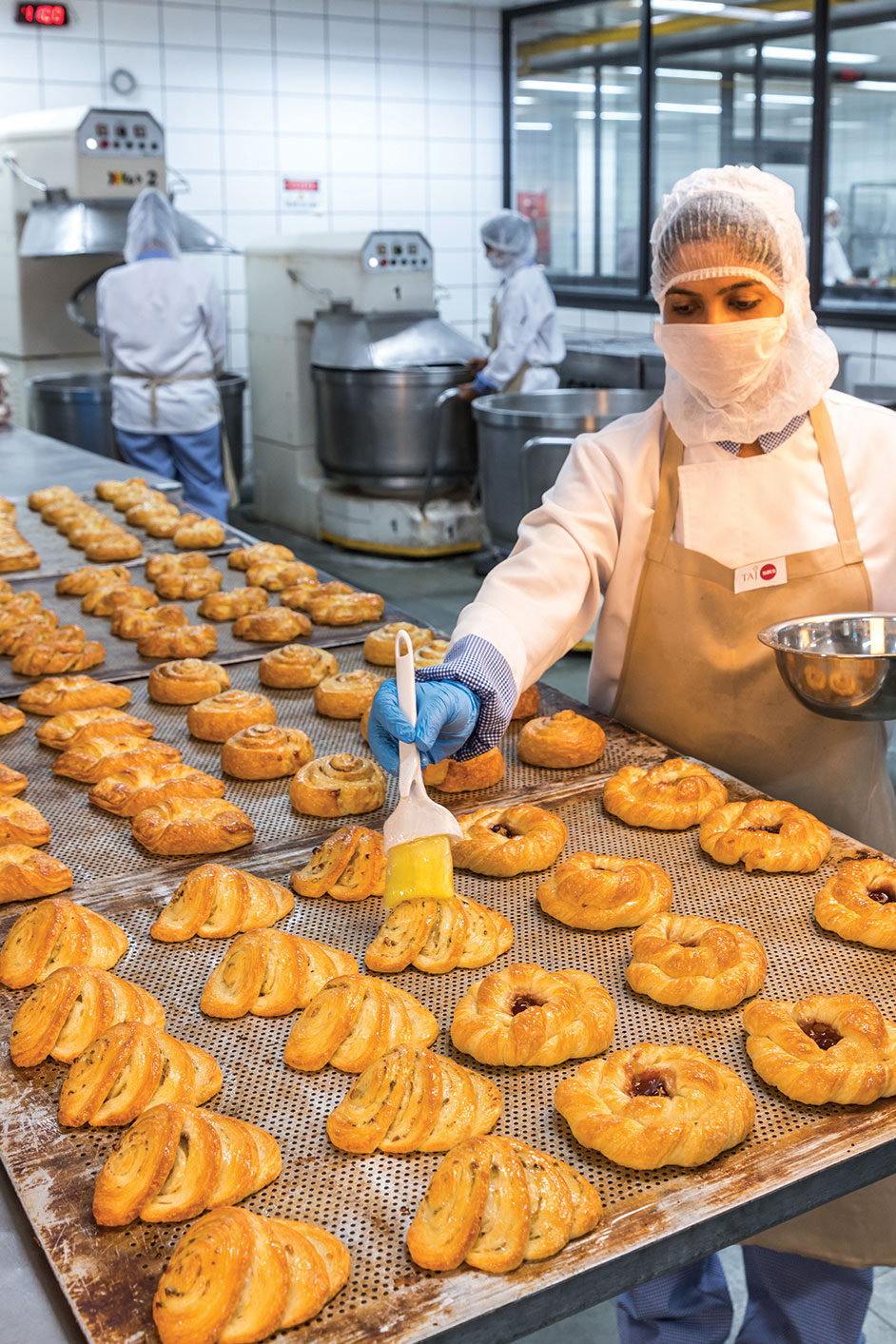
Preparing for altitude
As per industry practice, Economy Class meals are standardised for cost-efficiency, while First Class and Business Class meals have more elaborate dishes and plating. TajSATS also has to modify its offerings for passengers who have allergies, dietary restrictions or religious needs. Halal, kosher, gluten-free and vegan are some of the options available.
Chef Nayal admits it can sometimes be a challenge to pull it all together. More so, when it comes to serving important dignitaries, such as the prime minister, president and vice president, when an additional layer of security is placed at their units. “Catering to these flights is all the more difficult as the menus are elaborate and there can be last-minute requests which need to be complied with,” he says. The most unusual meal request they have received? A ‘halal’ fruit platter. Currently, the most popular dishes are chicken junglee sandwich, walnut brownie, samosa and cheesecake.
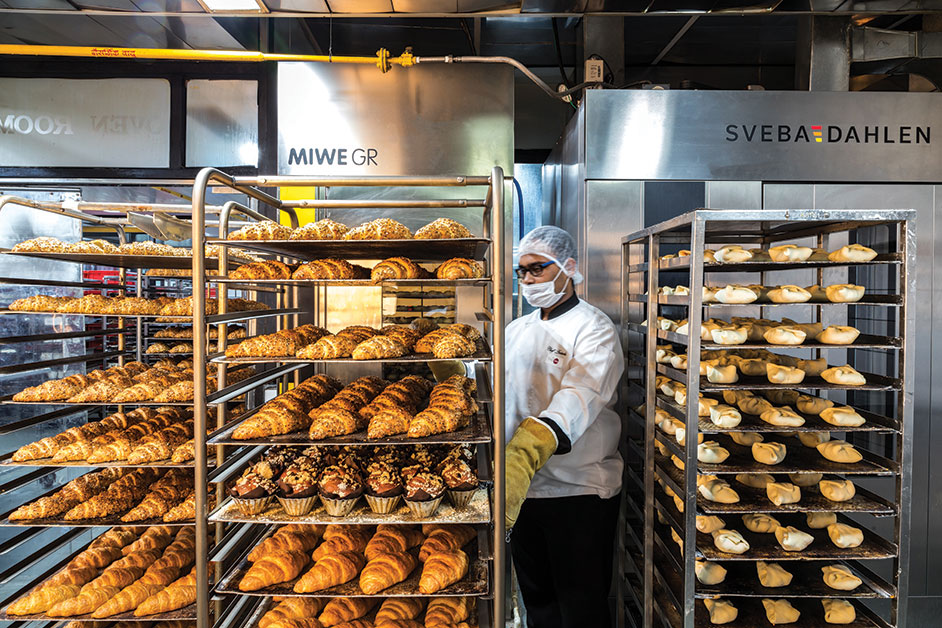
Once food items have been sufficiently chilled, they are taken to the vegetarian and non-vegetarian Portioning sections, where associates, like a choreographed troupe, work across assembly lines. Identical meal items are laid out en masse, plated in their respective containers — as per a reference ‘golden sample’ — and final touches, like garnishes are added. After another temperature check, the items are transported to the Operational area, where the meal trays are assembled with precision and a close eye on the clock to ensure they are ready well in time for delivery, which is typically two hours before take-off to ensure freshness and compliance with guidelines.
The neatly packed trays are loaded on to aircraft trolleys that are labelled with the flight number, cabin class and destination. The trolleys are then transported to the airport’s high lifts (specialised vehicles) that are designed to transfer in-flight meals and beverages directly from the flight kitchen to the aircraft. The next time these trolleys will be opened is when it’s time for a meal 35,000 feet up in the air.
Sustained growth
Aviation currently comprises 85% of TajSATS’ business and the company expects to continue its growth momentum — it clocked a revenue of ₹900 crore in FY24 (a 35% growth) and is ready to touch ₹1,040 crore this year. One of the factors driving this progress is the government’s UDAN (Ude Desh ka Aam Nagrik) initiative which aims to enhance regional air connectivity by making air travel affordable and accessible to those living in Tier 2 and Tier 3 cities. “The idea is to be present wherever there is expansion in India,” says Mr Gupta. “This includes new airports coming up in places like Varanasi and Ayodhya, as well as emerging tourist destinations like Port Blair.”
The company is also rapidly expanding Nekta Food Solutions, its institutional catering business that offers curated solutions. “The pandemic taught us to never put all our eggs in one basket,” says Mr Gupta, adding that there are plans to expand the brand’s presence from Gurugram to other key cities in the country.
- Anju Maskeri




